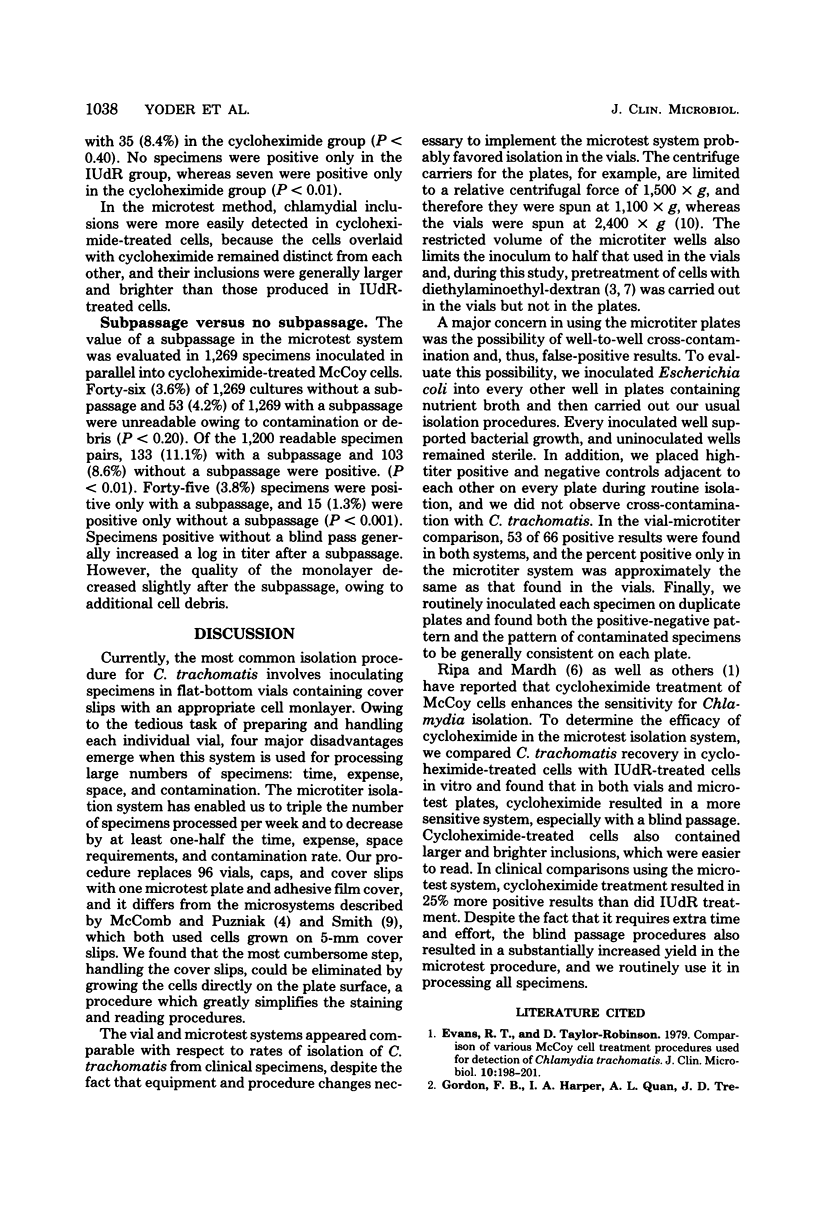Abstract
Management of patients potentially infected with Chlamydia trachomatis has been hampered by the cost and time required to perform Chlamydia cultures. To isolate C. trachomatis, we developed a microtiter method that exhibited equal sensitivity but less frequent contamination than our previously used vial-cover slip culture system. In addition, costs and technician time were substantially reduced with the microtest method. Subsequent studies showed that cycloheximide-treated cells were superior to 5-iodo-2-deoxyuridine-treated cells in the microtest method and that a subpassage significantly enhanced the sensitivity of the method. The microtest method appears to be a sensitive, rapid, and economical method for isolating C. trachomatis.
Full text
PDF



Selected References
These references are in PubMed. This may not be the complete list of references from this article.
- Evans R. T., Taylor-Robinson D. Comparison of various McCoy cell treatment procedures used for detection of Chlamydia trachomatis. J Clin Microbiol. 1979 Aug;10(2):198–201. doi: 10.1128/jcm.10.2.198-201.1979. [DOI] [PMC free article] [PubMed] [Google Scholar]
- Gordon F. B., Harper I. A., Quan A. L., Treharne J. D., Dwyer R. S., Garland J. A. Detection of Chlamydia (Bedsonia) in certain infections of man. I. Laboratory procedures: comparison of yolk sac and cell culture for detection and isolation. J Infect Dis. 1969 Oct;120(4):451–462. doi: 10.1093/infdis/120.4.451. [DOI] [PubMed] [Google Scholar]
- Kuo C., Wang S., Wentworth B. B., Grayston J. T. Primary isolation of TRIC organisms in HeLa 229 cells treated with DEAE-dextran. J Infect Dis. 1972 Jun;125(6):665–668. doi: 10.1093/infdis/125.6.665. [DOI] [PubMed] [Google Scholar]
- McComb D. E., Puzniak C. I. Micro cell culture method for isolation of Chlamydia trachomatis. Appl Microbiol. 1974 Oct;28(4):727–729. doi: 10.1128/am.28.4.727-729.1974. [DOI] [PMC free article] [PubMed] [Google Scholar]
- Ripa K. T., Mårdh P. A. Cultivation of Chlamydia trachomatis in cycloheximide-treated mccoy cells. J Clin Microbiol. 1977 Oct;6(4):328–331. doi: 10.1128/jcm.6.4.328-331.1977. [DOI] [PMC free article] [PubMed] [Google Scholar]
- Rota T. R., Nichols R. L. Infection of cell cultures by trachoma agent: enhancement by DEAE-dextran. J Infect Dis. 1971 Oct;124(4):419–421. doi: 10.1093/infdis/124.4.419. [DOI] [PubMed] [Google Scholar]
- Schachter J. Chlamydial infections (second of three parts). N Engl J Med. 1978 Mar 2;298(9):490–495. doi: 10.1056/NEJM197803022980905. [DOI] [PubMed] [Google Scholar]
- Smith T. F. Comparative recoveries of chlamydia from urethral specimens using glass vials and plastic microtiter plates. Am J Clin Pathol. 1977 May;67(5):496–498. doi: 10.1093/ajcp/67.5.496. [DOI] [PubMed] [Google Scholar]
- WEISS E., DRESSLER H. R. Centrifugation and Rickettsiae and viruses onto cells and its effect on infection. Proc Soc Exp Biol Med. 1960 Apr;103:691–695. doi: 10.3181/00379727-103-25637. [DOI] [PubMed] [Google Scholar]
- Wentworth B. B., Alexander E. R. Isolation of Chlamydia trachomatis by use of 5-iodo-2-deoxyuridine-treated cells. Appl Microbiol. 1974 May;27(5):912–916. doi: 10.1128/am.27.5.912-916.1974. [DOI] [PMC free article] [PubMed] [Google Scholar]
- Wentworth B. B. Use of gentamicin in the isolation of subgroup A Chlamydia. Antimicrob Agents Chemother. 1973 Jun;3(6):698–702. doi: 10.1128/aac.3.6.698. [DOI] [PMC free article] [PubMed] [Google Scholar]


